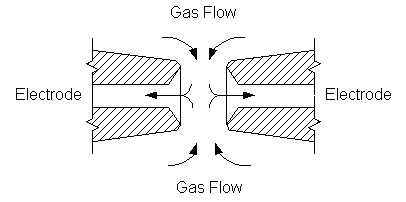
The nominal blast gap design, as described by Früngel, after Marx, has radially inflowing gas through the gap, with the exhaust along the central axis of the electrodes. A cross section of this type of gap is shown below.

There are some practical limits for the voltage on this type gap. The ion path between the electrodes has to be able to be made before it is blown out, and a suggested limit is a 2 cm spacing and 60 kV voltage. Früngel cites examples where these gaps are used in induction heating systems at 10-50 kHz repetition rates, at voltages in the 10-15 kV range, with energies of 1-2 Joules per discharge. In this sort of application, a capacitor and the workpiece inductor form a resonant circuit with a resonant frequency of several hundred kHz.
The RQ (or Richard Quick) gap is a form of blast gap popular among tesla coil experimenters. It is a multi segment gap made of sections of copper tubing with moderate air flow axially through the assembly. The term blast is probably misleading in this case, because the air supply is a small ventilating fan (i.e. a "muffin fan") providing m/sec (50-100 cfm) air flows.

RQ gap end view, showing parallel copper tube sections

RQ gap top (or side) view, showing muffin fan blowing through assembly.
Copyright 2001, Jim Lux / blastgap.htm / 18 March 2001 / Back to HV Home / Back to home page / Mail to Jim